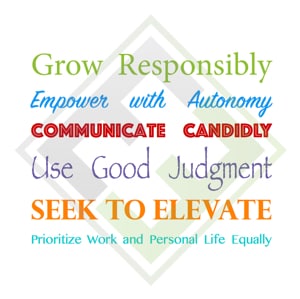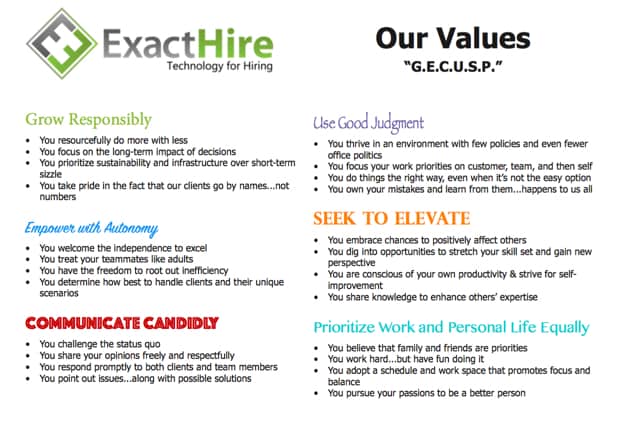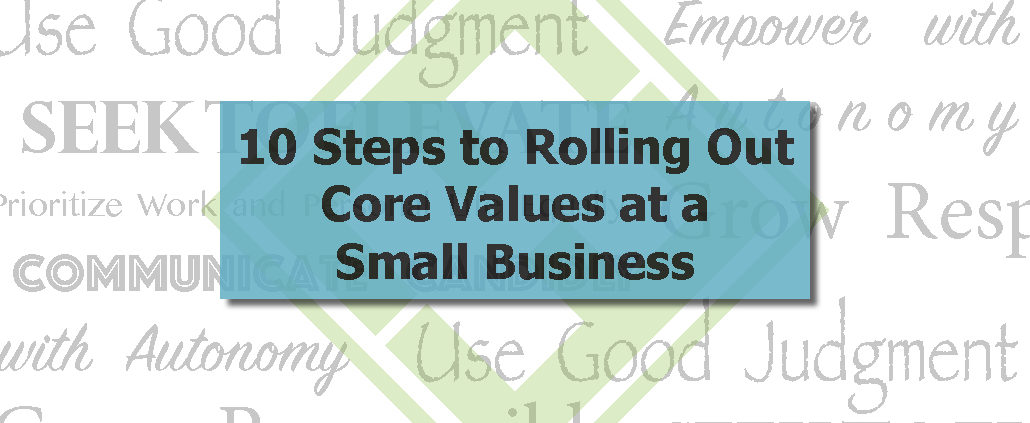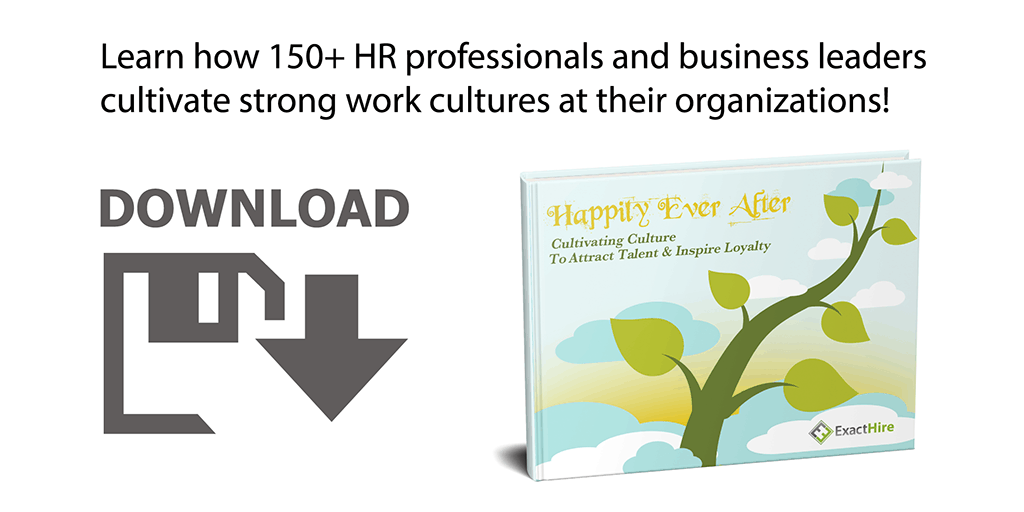10 Steps to Rolling Out Core Values at a Small Business
There are many reasons that organizations choose not to craft a core set of values. Sometimes, senior management doesn’t think core values are a big deal because they think every employee already knows how they are supposed to act to succeed. Or, key employees may have had a bad experience with values at a previous organization that were essentially meaningless. Moreover, not having any recognized values relieves any obligation for an employer to deal with employees who would not live up to a set of corporate values.
If it’s too easy for your organization to find an excuse not to commit to forming a relevant, celebrated value statement, then your business will never reach its full potential. It’s just not possible when conditions aren’t in place to align a workforce with the principles that an employer holds sacred.
At ExactHire, we only very recently rolled out our core values. While the company has been in business since 2007, our management team had some of the same objections that I initially mentioned. However, when we first decided that it was time to make a change and embrace the value process, we made the classic rookie mistake of involving everyone. As you can imagine, it resulted in a hot mess of groupthink…complete with vanilla platitudes that can only result from trying to be everything to everyone. And not surprisingly, the trite single-word adjectives we selected were quickly forgotten.
The Better Way to Craft Core Values
However, after some frank internal banter and a commitment to make our values amount to more than just a framed wall poster, we embarked on a mission that led us to G.E.C.U.S.P.

While we’re extremely happy with these new core values, we fell a little short on a catchy acronym. But hey, there’s only so many ways to rearrange letters. In this blog, I’ll share our process for creating, unveiling and embracing the ExactHire core values that truly represent our small business.
1 – Owner ownership
We were fortunate to learn, with only a minor hiccup, that you can’t involve everyone if you’re going to capture the true values of your organization. Keep your values “discovery team” small, and ideally comprised of only your founder(s) and perhaps certain long-tenured senior managers. The values of the organization should reflect the values of the founders, and so owner ownership of the process is essential. They are the ones that will model the behavior to the rest of the organization.
2 – Give context and get buy-in
Especially when members of your values discovery group are skeptical about the potential impact of spending time on core value development, you must set clear expectations. Talk about what will be different this time compared to their past experiences and get their feedback. Discuss ways in which the values will be woven into daily work life beyond the initial announcement. Assign stakeholders to own various values initiatives.
Then, consider announcing to the rest of the company that you are creating values and that it is a process that is taken very seriously. Then, when the eventual values are announced later, employees will know that they were formed with careful intention and not just copied from some business book.
3 – Brainstorm independently, but with parameters
Each member of the small discovery team should come up with a list of values on his/her own. If you’ve selected the right core group of people (e.g. founders, key long-time employees), and they are being honest about how work is really done at the organization, then their separate lists should have many similarities.
However, to start them down a productive path, clarify the following:
- They are to list actual core values, not aspirational values. As Patrick Lencioni details in this Harvard Business Review article, aspirational values may be necessary for the company’s eventual success, but are not representative of the traits that the company can honestly claim today.
- They should avoid one-word overused “no duh” adjectives like “innovation” or “integrity.” At ExactHire, our team focused on short phrases.
- They are welcome to look at values from other organizations that they believe have a similar culture to get the creative juices flowing.
4 – Collaborate to edit and refine
In our experience, we knew we were on the right track–as when we gathered to compare notes–our lists were about an 85% match. That reassured us that we were on the right path, and then the process of rephrasing statements and combining categories to come up with a succinct list was relatively painless.
During this process, we honed our list by asking questions like these:
- Are these actual or aspirational values?
- Are there any obvious outliers that won’t seem authentic to employees?
- Is the language gritty enough to represent how we do business? Does it make our priorities clear?
- Are these values complementary to our employment brand? Strategic planning process? Performance management process?
5 – Simmer
Once we were content with our final values list, we knew that we had to give it some time to make sure it really fit the organization. We tabled the process for a couple of months in order to let them sink in to ensure their credibility before announcing them to the rest of the organization.
6 – Plan a big reveal
The definition of “big” will depend on your organization’s size. However, no matter the size, don’t just send out an email or make a quick announcement that your new values are posted. Plan a reveal that will be memorable and engage employees to quickly learn the values.
At ExactHire, we planned the announcement during our monthly company meeting, and took time to explain how we approached the process and why we involved a very small group of employees. Prior to the unveiling, we designed a logo that incorporates color and different fonts to make it easy to remember our G.E.C.U.S.P. However, we knew that employees wouldn’t necessarily take it upon themselves to periodically glance at the logo. So, we ordered die-cut laptop stickers (from my new obsession Sticker Mule) and presented them to employees during the meeting.

Tom, Jess and Darythe showing off ExactHire core values!
Now, many of the laptops you see around our office proudly sport our values and make it easy for them to be top-of-mind. While stickers may be the norm for a software company, if mugs, water bottles or magnets are more your speed–go for it! The point is to select an item that is frequently close to your employees and reinforces the values visually on a daily basis.
In our meeting, we also handed out the unabridged internal document that defines our values…complete with bullet points that clarify what each short phrase means.

7 – Cultivate employee values engagement
To add to the excitement of our initial roll-out, we wanted to keep the momentum going in the early adoption phase by giving employees the optional opportunity to participate in a t-shirt design contest. We had been meaning to get company t-shirts for some time anyway (what cool tech company doesn’t have an employee picture in matching shirts after all?), and this seemed like the perfect chance to meet that need while getting teammates excited about incorporating values into an aspect of our culture.
We passed out this contest rules flyer during the company meeting, and employees were invited to select the winning t-shirt design via anonymous survey a week later.

And the winner is…

NOTE: We haven’t produced them yet at the time of this writing…hence no cool team picture in matching outfits yet–stay tuned!
While our contest rules didn’t stipulate that the new values had to be explicitly represented on the t-shirt, I was pleased that the majority of the submitted designs did actually incorporate the values anyway…a sign that we were on the right track. If employees don’t believe you’ve selected the right values, they won’t want to wear them!
Here are some other values engagement ideas:
- Plan book club discussions about books that are based on some of your selected values.
- Challenge employees to self-identify how they can better align their own work and behavior to core values.
- Invite employees to blog about how they see values represented at the organization from their own perspective. This is a great way to promote your values to the external world in a very authentic way, as well.
8 – Share your values externally
Don’t stop at blogging when it comes to sharing your values outside of your organization. Organizations that walk the talk will be more attractive to job seekers, potential customers and business partners. Consider the following ideas:
- Include your values graphic on your company’s “about” page.
- Weave values into your jobs portal or applicant tracking system. Include a link to information about your values in job descriptions. This is a great tool to get some less desirable applicants to self-select out of your hiring process.
- Create a slide deck about your core values that can be embedded in social media posts and web pages.
- Invite employees to do testimonials that talk about how each of your values impacts their work life. These can be in written and/or video format.
- Use your values as a basis for selecting organizations with which to partner for charitable donations and volunteer hours. When contributing silent auction items to noteworthy causes, choose items that can be easily tied to your values.
- Creatively display your values in your working space, especially in places where customers, partners and job candidates will visit.
9 – Live your values everyday
Don’t fall into the dreaded cliche of rolling out values and then forgetting about them the next day. Build in triggers to live them. For example, if you are in Human Resources, a department that helps champion work culture and supports senior management initiatives, set periodic reminders to intentionally think about values and how recent events can be correlated to them. For example, if a customer sends in a “happy note” about the service he received, then have a founder forward the note to the entire company with a comment that ties it back to a specific core value being positively represented.
Other ideas for reinforcing core values:
- Make them the deciding factor on company decisions.
- Use them to inspire internal traditions like “Monday Funday”.
- Evaluate whether your performance management process appropriately accounts for employees’ embodiment of core values.
- Revisit your interview process and incorporate questions that give you an opportunity to discuss core values with job candidates.
- If your organization is large enough, consider a quarterly prize that recognizes individuals who have done something that specifically reinforces a certain value. Document these employee stories and share them with incoming employees to build a tradition of celebrating value alignment.
10 – Re-evaluate your values periodically
It’s important to be vigilant about engaging employees to your core values, as well as ensuring that senior management models them appropriately. Additionally, while core values would rarely (if ever) change for an organization (assuming founders remain involved), there may be times when an additional value is warranted.
Conduct employee pulse surveys from time to time to ask questions that will help you take the temperature on whether the organization needs to be doing more to promote value alignment.
I hope that the lessons we learned during the value formation process for ExactHire can help inspire action for other small- and medium-sized employers. We’re still in the learning process, too, as we look for more ways to reinforce them everyday…but we’re heading in the right direction.
For more information on building work culture, and how it starts with eliminating bad hires, consult out Free ATS Guide.










